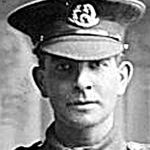Private G/71256 2nd Bn, Royal Fusiliers (City of London) Regiment
Died 13th April 1918, aged 39
Remembered at Ploegsteert Memorial
but not in Blakeney
Charles was born 16th January 1879 at Brooke, Norfolk, the eldest son of Robert John Bullen, shoemaker, and his wife Lucy. The 1911 census reveals that Charles was still single, aged 32 and in domestic service as Butler to Ella Holmes of The Hall Brooke. Then towards the end of 1913 he married Gertrude R. Adams in Norwich.
A chance discovery of him was on the internet site “Picture Norfolk” where he was identified as Charles Henry Bullen, Royal Fusilier of Blakeney. The photograph however, clearly displays the Britannia badge of the Norfolk Regiment. This immediately led to further research as no Charles Bullen featured on either the Blakeney War Memorial or in any other contemporary village sources. He has since been found in Kelly’s Directory for 1916 where he is listed in the Commercial section with no indication of his trade.
There are no Service Records for Charles, only his listing in “UK Soldiers Died in the Great War 1914-1919”, a Medal Card and his entry in the “Army Register of Soldiers’ Effects 1901-1929”. However, the information from these few records confirms that he was indeed a resident of Blakeney when he enlisted at Cromer. Furthermore, Charles was initially with the 5th Norfolk Regiment before he was later, date unknown, transferred to the Royal Fusiliers. By April 1918, his Battalion was part of the XV Corps in the British First Army led by General Sir Henry Horne.
Both the First and Second British Armies took part in the second phase of the German Spring Offensives at the Battle of Lys, 9th -11th April, 1918. On this occasion the objective of the German Army was to capture key road and rail networks supporting the Second British Army located further towards Ypres. The First Army engaged the enemy at Estaires between 9th and 11th April. This was the opening phase of the Battle of Lys (9th-29th April), when German storm troopers made rapid advances and crossed the River Lys. The following day the British were forced to retreat back from Estaires towards the rail junction at Hazbrouck while the Royal Fusiliers were ordered, at noon, to join the Second Army at Bailleul. Charles seemingly lost his life the next day.
However, close inspection of the Register of his “Effects” reveals a quite different story. His death actually occurred sometime between 11th and 13th April, the exact date and place being unknown. Thus he was killed in action either on the last day of the initial skirmish at Estaires or en route to the Second Army and it would appear that his absence was not immediately noticed. His body was and never has been recovered and consequently his name features on the Panel for the missing at Ploegsteert Memorial and also at Brooke where he was born.

